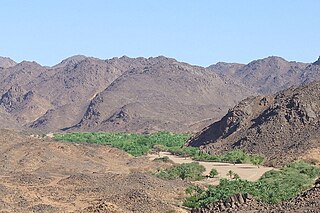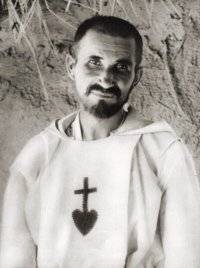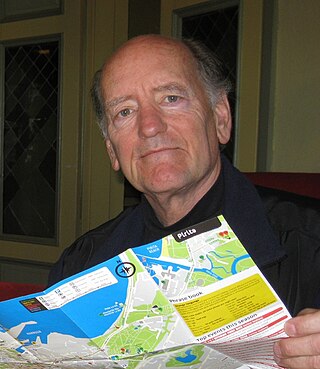Related Research Articles

The Tuareg people are a large Berber ethnic group that principally inhabit the Sahara in a vast area stretching from far southwestern Libya to southern Algeria, Niger, Mali, and Burkina Faso. Traditionally nomadic pastoralists, small groups of Tuareg are also found in northern Nigeria.

The Sahara is a desert spanning across North Africa. With an area of 9,200,000 square kilometres (3,600,000 sq mi), it is the largest hot desert in the world and the third-largest desert overall, smaller only than the deserts of Antarctica and the northern Arctic.

Tinariwen is a collective of Tuareg musicians from the Sahara region of northern Mali. Considered pioneers of desert blues, the group's guitar-driven style combines traditional Tuareg and African music with Western rock music. They have released nine albums since their formation and have toured internationally.

The Aïr Mountains or Aïr Massif is a triangular massif, located in northern Niger, within the Sahara. Part of the West Saharan montane xeric woodlands ecoregion, they rise to more than 1,800 m (5,900 ft) and extend over 84,000 km2 (32,000 sq mi). Lying in the midst of desert north of the 17th parallel, the Aïr plateau, with an average altitude between 500 and 900 m, forms an island of Sahel climate which supports a wide variety of life, many pastoral and farming communities, and dramatic geological and archaeological sites. There are notable archaeological excavations in the region that illustrate the prehistoric past of this region. The endangered African wild dog once existed in this region, but may now be extirpated due to human population pressures in this region.

Agadez, formerly spelled Agadès, is the fifth largest city in Niger, with a population of 110,497 based on the 2012 census. The capital of the eponymous Agadez Region, the city lies in the Sahara desert, and is also the capital of Aïr, one of the traditional Tuareg–Berber federations. The historic centre of the town has been designated a World Heritage Site by UNESCO.
Taghaza is an abandoned salt-mining centre located in a salt pan in the desert region of northern Mali. It was an important source of rock salt for West Africa up to the end of the 16th century when it was abandoned and replaced by the salt-pan at Taoudenni which lies 150 km (93 mi) to the southeast. Salt from the Taghaza mines formed an important part of the long distance trans-Saharan trade. The salt pan is located 857 km (533 mi) south of Sijilmasa, 787 km (489 mi) north-northwest of Timbuktu and 731 km (454 mi) north-northeast of Oualata.

Trans-Saharan trade is trade between sub-Saharan Africa and North Africa that requires travel across the Sahara. Though this trade began in prehistoric times, the peak of trade extended from the 8th century until the early 17th century CE. The Sahara once had a different climate and environment. In Libya and Algeria, from at least 7000 BCE, pastoralism, large settlements and pottery were present. Cattle were introduced to the Central Sahara (Ahaggar) between 4090 to 3500 BCE. Remarkable rock paintings in arid regions portray flora and fauna that are not present in the modern desert.

Murzuk, Murzuq, Murzug or Merzug is an oasis town and the capital of the Murzuq District in the Fezzan region of southwest Libya. It lies on the northern edge of the Murzuq Desert, an extremely arid region of ergs or great sand dunes which is part of the greater Sahara Desert.

Charles Eugène, vicomte de Foucauld de Pontbriand,, commonly known as Charles de Foucauld, was a French soldier, explorer, geographer, ethnographer, Catholic priest and hermit who lived among the Tuareg people in the Sahara in Algeria. He was assassinated in 1916. His inspiration and writings led to the founding of a number of religious communities inspired by his example, such as the Little Brothers of Jesus.

Kel Ahaggar is a Tuareg confederation inhabiting the Hoggar Mountains in Algeria. The confederation is believed to have been founded by the Tuareg matriarch Tin Hinan, whose monumental tomb is located at Abalessa. The official establishment is dated to around 1750. It has been largely defunct since 1977, when it was terminated by the Algerian government.
Desert exploration is the deliberate and scientific exploration of deserts, the arid regions of the earth. It is only incidentally concerned with the culture and livelihood of native desert dwellers. People have struggled to live in deserts and the surrounding semi-arid lands for millennia. Nomads have moved their flocks and herds to wherever grazing is available, and oases have provided opportunities for a more settled way of life. Many, such as the Bushmen in the Kalahari, the Aborigines in Australia and various Indigenous peoples of the Americas, were originally hunter-gatherers. Many trade routes have been forged across deserts, especially across the Sahara Desert, and traditionally were used by caravans of camels carrying salt, gold, ivory and other goods. Large numbers of slaves were also taken northwards across the Sahara. Today, some mineral extraction also takes place in deserts, and the uninterrupted sunlight gives potential for the capture of large quantities of solar energy.

Iferouane, also spelled Iferouan, is an oasis town and commune in northern Niger, in Agadez Department. It is located northeast of Arlit in the northern Aïr, in the Ighazar valley near the Tamgak Range.

Tishoumaren or assouf, internationally known as desert blues, is a style of music from the Sahara region of northern and west Africa. Critics describe the music as a fusion of blues and rock music with Tuareg, Malian or North African music. Various other terms are used to describe it including desert rock, Saharan rock, Takamba, Mali blues, Tuareg rock or simply "guitar music". The style has been pioneered by Tuareg musicians in the Sahara region, particularly in Mali, Niger, Libya, Western Sahara, Algeria, Burkina Faso and others.

The Sultanate of Agadez was a Berber kingdom centered in the city of Agadez in the Aïr Mountains, located at the southern edge of the Sahara desert in north-central Niger. It was founded in 1430 by the Tuareg and Hausa people as a trading post. The Agadez Sultanate was later conquered by the Songhai Empire in 1500. After the defeat of the Songhai kingdom in 1591, the Agadez Sultanate regained its independence. It experienced a steep decline in population and economic activity during the 17th century. The sultanate came under French suzerainty in 1906.

Désert is a 1980 novel written by French Nobel laureate writer J. M. G. Le Clézio, considered to be one of his breakthrough novels. It won the Académie française's Grand Prix Paul Morand in 1980.
The Last Flight is a 2009 French film. Directed by Karim Dridi, it stars Marion Cotillard and Guillaume Canet. The film is based on the French novel Le dernier vol de Lancaster by Sylvain Estibal which is loosely based on the real life events surrounding the disappearance of British aviator Bill Lancaster.

"Count" Byron Khun de Prorok was a Hungarian-American amateur archaeologist, anthropologist, and author of four travelogues. He has come to be regarded as a tomb raider, or grave robber, opening up graves and tombs and removing remains and artefacts against the wishes of those laying claim to them.

David Wadsworth Ball is an American author whose novels include Empires of Sand (1999), China Run (2002) and Ironfire (2004). His short story, The Scroll, was published in Warriors (2010), and Warriors 2 (2010), anthologies assembled by George R.R. Martin and Gardner Dozois. The short story Provenance was included in an anthology entitled Rogues, published by Bantam Spectra in 2014.

Paul Flatters was a French soldier who spent a long period as a military administrator in Algeria. He is known as leader of the Flatters expedition, an ill-fated attempt to explore the route of a proposed Trans-Saharan railway from Algeria to the Sudan. Almost all members of the expedition were massacred by hostile Tuaregs. The survivors resorted to eating grass and to cannibalism on the long retreat through the desert. After a brief outburst of public indignation the fiasco was forgotten.